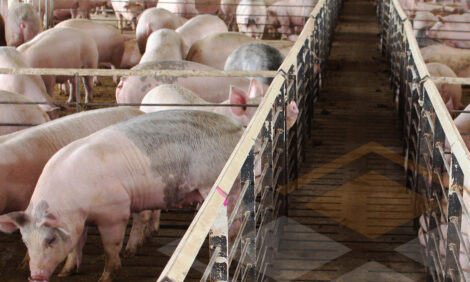



Foot and Mouth Disease – Asia's Fastest Growing Challenge?
"FMD control has been an enduring priority globally and today presents the fastest growing challenge facing Asia," stated Dr Sacha Seneque of Merial Australia, at the 5th Asian Pig Veterinary Society Congress, held last month in Pattaya, Thailand, writes Stuart Lumb for ThePigSite.Efforts in pursuit of FMD control have had enormous political, financial and emotional impact. Dr Seneque cited the recent outbreaks in Korea and Japan as examples, in terms of the impact these two outbreaks have had on the respective countries. The current type O outbreak in South Korea is the worst in the country's history and and the most significant in the world since the the UK outbreak in 2001.
Many will remember the unprecedented media coverage and the concerns about how that outbreak was handled. When animal suffering and destruction are measured in millions of head and where the financial impact is measured in millions of UK pounds and where the social and emotional costs are inordinately high the quest to improve control efforts and minimise FMD's destructive impacts are worthy priorities.
FMD's impact is growing in Asia due to several factors:
- The disease has greater negative effects on growing populations of improved and more efficient production animals
- There is greater virus risk of virus spread due to increased movement of humans and livestock products
- There is an increasing gap between the developed and developing countries in Asia.
The result is that we are faced with a situation where increased populations of concentrated and highly susceptible animals are having greater risks of being exposed to FMD virus (FMDV).
FMDV has a discrete range of serotypes (seven are known to exist) and several sub-types each with an ability continually to evolve and mutate, contributing to wide genetic and antigenic variation, plus the disease can be spread in widely ranging ways.
The epidemiology of FMD in Asia is influenced by a combination of factors, said Dr Seneque. This includes: variation in the virus strain; the consistency of effective control measures and new strain introductions (originating from distant outbreaks that are transmitted via animal movement or other mechanisms) to susceptible populations. Seasonal and cyclical periods of increased disease prevalence are observed, suggesting that there are factors that favour periods of increased transmission or host susceptibility that predispose epizootic risk.
The current state of play in Asia is as follows, regarding the distribution of FMD viruses, Dr Seneque continued. Today, serotypes O, A and Asia 1 are considered endemic in one or more of the FMD-affected countries in Asia, with type C having last been reported in the Philippines in 1995. Type O strains have been responsible for the most severe epidemics experienced in Asia, e.g. Taiwan in 1997 and Korea in 2009/10.
Virus Spread
It is accepted that the most important endemic mechanism of virus spread in Asia is by live animal movement, both within disease-affected countries and and across borders. This is largely driven by the economics of trade, explained Dr Seneque. Cattle, buffalo or pig movements are the source (or implicated) in most cases, and well documented trading patterns that reflect local demand have a high correlation to outbreak risk factors and disease 'hotspots' in the Indochina region.
In the absence of other possible sources, the many biosecurity failures observed over recent years suggest that people have been responsible for transferring FMD between farms. This may prove to be an important and underestimated transmission risk within this region.
Country/Zone FMD status
Classification with Zone 1 is given to those countries or regions that are FMD-free, where routine vaccination is not practised.
In Zone 2 are countries or zones where FMD is endemic. This group is subdivided into Zone 2a, i.e. areas where commercial livestock enterprises are not well developed, veterinary services may be weak and FMD cases are not uncommon, and Zone 2b, i.e. those that have well developed commercial sectors with interests in securing and developing the considerable premium trade opportunities that present with increased market access. These countries generally have well developed veterinary services.
Vaccination
In FMD-endemic countries, vaccines are often regulated to aid vaccination compliance aims and to ensure appropriate quality vaccines are used. In Asia, available FMD vaccines are routinely used in the vast majority of commercial herds (usually at the producer's motivation and expense) and today, more than 95 per cent of pigs in commercial units are vaccinated.
In FMD-free countries, routine use of FMD vaccination is banned (in compliance with OIE disease-free status requirements).
FMD vaccination limitations exist: vaccination with one FMD serotype does not confer cross-protection against other serotypes, plus vaccine efficacy may vary between isolates of the same FMD serotype if antigenic diversity is great.
Experiences and Challenges
Recent years have seen several regional countries secure 'Disease-Free' recognition that have required validation of disease freedom after disease, e.g. South Korea and Japan, eradication from an established endemic or outbreak situations, e.g. Philippines and Indonesia). Others, although not disease-free, have reduced outbreak prevalence to sporadic outbreaks, e.g. Taiwan, Viet Nam and Thailand, after successful implementation of comprehensive disease control initiatives.
Dr Seneque concluded that Asia has unique diversity that is relevant to trans-boundary disease movement risks, e.g. animal movement pathways. Add to this the dynamic socio-economic and urbanisation changes that can influence disease epidemiology and it could be viewed as inevitable that there will be FMD movement from endemic hot-spots or outbreak areas to neighbouring geographies.
FMD in South Korea: an Update
Dr Seneque gave an update on the current situation in South Korea. The outbreak started on 23 November 2010 and, within six weeks, it had spread over 60 per cent of the country. By the end of December, it was realised that slaughtering was ineffective and so ring vaccination was implemented, followed by blanket vaccination. By early March 2011, huge numbers of animals had been slaughtered, including 2.2 million pigs. The army is now involved with movement controls, disinfection and vaccination now implemented.
Water and soil contamination has occurred and meat consumption has dropped due to consumers' food safety concerns. It is estimated that 40,000 jobs have been lost in the countryside as a consequence of FMD, the animal population has dropped by 30 per cent and the outbreak has had serious ramifications as far as the tourism industry is concerned.
Further Reading
| |
- | Find out more information on FMD by clicking here. |
April 2011






